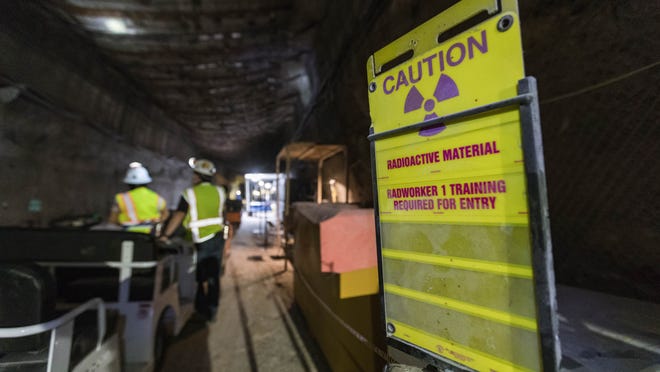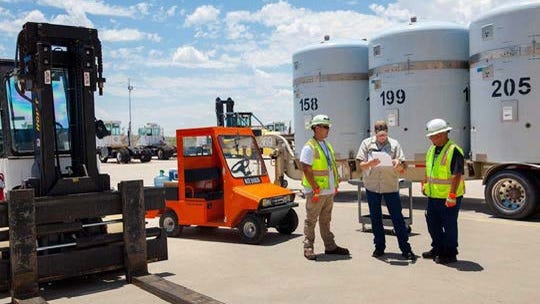Officials plan to ramp up operations as pandemic hoped to subside
“With continued increases in shipments, WIPP officials said they hoped to fill the seventh disposal panel by the middle of 2022, planning to begin emplacing waste in the eighth and final panel as mining the area was completed last year.”
Adrian Hedden Carlsbad Current-Argus January 31, 2022 currentargus.com
Officials from WIPP detailed the progress made in 2021 before state lawmakers Monday during the annual WIPP Legislative Breakfast held each year at the start of the Legislative Session.
This year’s presentation was held virtually via Zoom due to health concerns from the COVID-19 pandemic.
In the Fiscal Year 2021, about 199 shipments of waste were emplaced at WIPP, where they are permanently disposed of as an underground salt formation slowly collapses to bury the waste about 2,000 feet underground.
Shipments averaged about five weekly last year and were occasionally reported at seven or eight per week, said Reinhard Knerr, manager of the U.S. Department of Energy’s Carlsbad Field Office.
The facility’s target was about 240 shipments of waste for FY 2021, he said, and officials hoped to aim for up to 400 shipments in FY 2022.
“Unfortunately, COVID-19 has continued to be a significant challenge on that front,” he said of last year’s shipments. “We’ll be looking to increase here in the next few months.”
In early 2022, Knerr said WIPP hoped to increase shipments of waste to 10 to 12 per week from DOE nuclear facilities around the country including Los Alamos National Laboratory (LANL) in northern New Mexico.
Shipments from LANL recently drew concerns from state officials as the New Mexico Environment Department (NMED) called for federal oversight into how the DOE prioritizes shipments from around the country.
Meanwhile, the DOE announced plans to increase LANL’s production of plutonium pits, which are used to trigger nuclear bombs, to about 30 pits a year by 2026 – a move critics argued would increase waste generation at the site.
NMED Cabinet Secretary James Kenney in a letter to the Government Accountability Office asserted that New Mexico facilities should be prioritized.
In FY 2021, Knerr said shipments from LANL were increased to about 2 or 3 per week, contending the number of shipments from the facility that were ready for disposal were “limited.”
In total, FY 2021 saw 56 shipments of nuclear waste sent to WIPP from LANL.
“LANL’s shipment volumes that are ready to be emplaced are very limited,” Knerr said. “That’s good news for LANL because they can ship out their waste just as its ready.”
With continued increases in shipments, WIPP officials said they hoped to fill the seventh disposal panel by the middle of 2022, planning to begin emplacing waste in the eighth and final panel as mining the area was completed last year.
‘That was a huge accomplishment given COVID-19 and the resurgence of the Delta variant,” Knerr said of last year’s shipments. “I think FY 2021 was a successful year for us from a shipment perspective.”
Mining would also continue for two additional waste panels in the comings years, officials said.
Those panels would not mean an increase in WIPP’s statutory waste volume limit but would act as replacements for space lost to contamination after a 2014 accidental radiological release in the underground, which led to three-year pause of the site’s primary operations.
“We’ve had a lot of exciting accomplishments last year,” Knerr said. “Those accomplishments were significantly incredible given the COVID-19 pandemic. 2022 looks to be so as well.”
Aside from waste shipments, lawmakers were updated on multiple capital projects at the site focused on modernizing the facility and preparing it for continued disposal of radioactive materials.
Sean Dunagan, president at Nuclear Waste Partnership – WIPP’s primary operations contractor – said the site completed several large projects in 2021 while adjusting shifts and increasing remote work to avoid exposure to the virus.
“We’re adjusting crews, adjusting times so that people can minimize the amount of interactions they have,” Dunagan said. “Everything we do, we strive to do in safely and with compliance.”
Large projects at the site included an about $200 million rebuild of WIPP’s ventilation system along with a new utility shaft on the west side of the mine.
Dunagan reported that most of the equipment needed was on site, and that a fabrication building was completed, along with underground utilities.
Twenty-two air filtration units were onsite, he said.
The utility shaft was excavated about 116 feet down of its total depth of 2,275 feet underground.
The projects were intended to increase underground airflow to about 540,000 cubic feet per minute, a level that would allow for mining and waste emplacement activities to occur simultaneously.
Airflow was restricted after the 2014 event, another obstacle that limited waste disposal at WIPP in the years since.
“There’s a lot of work going on for the SSCVS on a daily basis,” Dunagan said.


